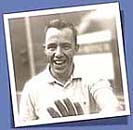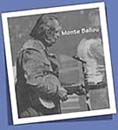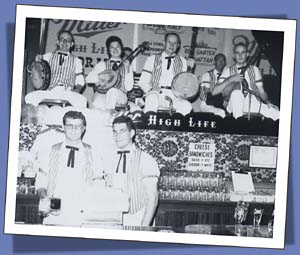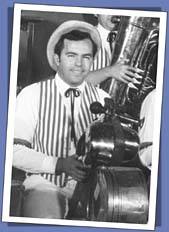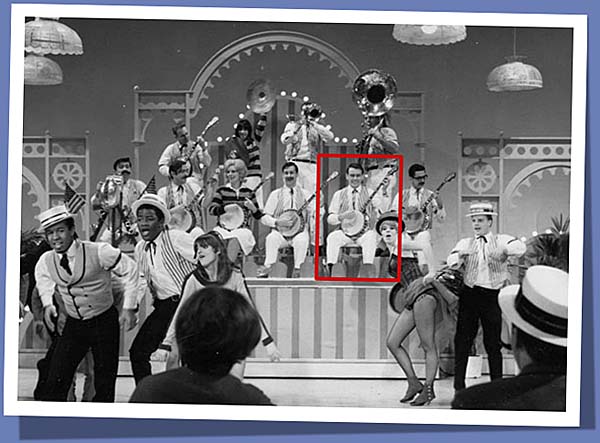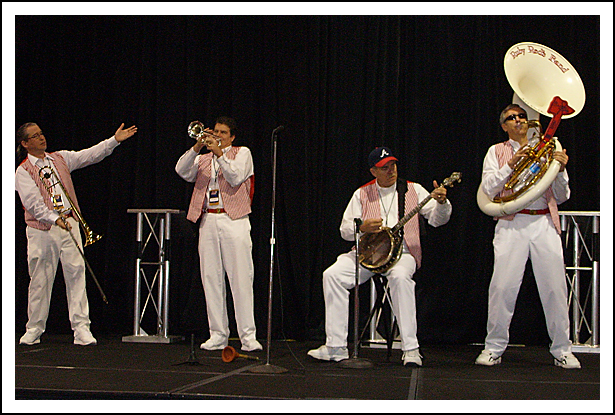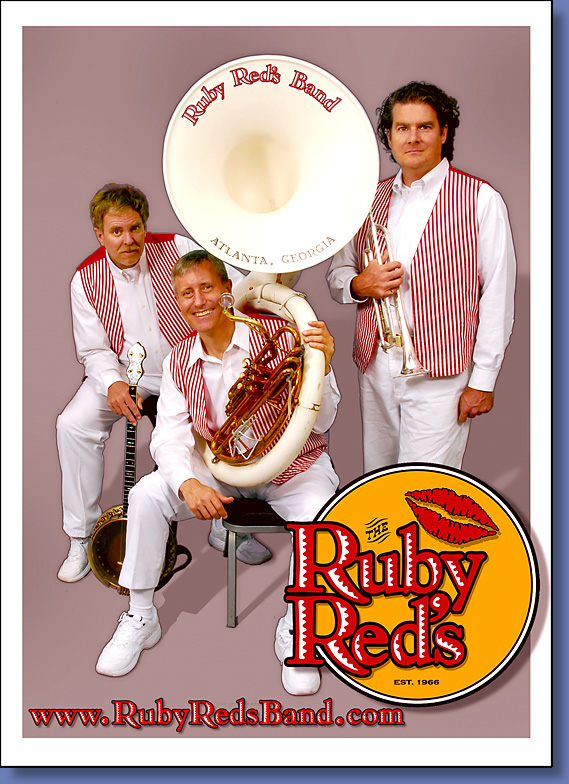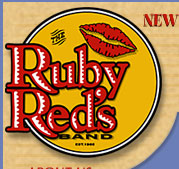 |
 |
|||||||||||||||||||||||
 |
|
|||||||||||||||||||||||
|
|
|||||
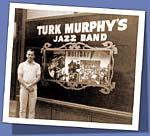 Hal outside Earthquake McGoon's in San Francisco |
Soon after joining Monte's band, Hal began to notice a young cornet player who would hang around outside the club where Monte played. His name was Ernie Carson and, although he was too young to get into the club, he had already started his own jazz band at his high school. He invited Hal to sit in and soon they became fast friends. Eventually Ernie began playing some with the Monte Ballou band. In 1955 Hal got a call from the great Turk Murphy and he proceeded to San Francisco to join Turk's band at the Tin Angel. Soon Hal went on the road with Turk for an extended stay in Las Vegas. During those 6 months or so with Turk, Hal had been ignoring his duties with the Oregon National Guard Band and was advised to return to Portland or face the draft. Hal had to leave Turk and the Las Vegas gig behind and finish his Guard hitch back in Portland while playing again with Monte Ballou. About that time Ernie joined the Marines and headed for duty in San Francisco and while there Ernie also pulled a hitch with the Turk Murphy Band. In 1962, as Hal's Guard duty came to a close, Turk again persuaded Hal to move to San Francisco and join Turk's Band at Earthquake McGoon's. On his nights off, Hal would hang out in a little banjo/sing-along parlor where Ernie was working. Hal got to know the musicians very well and even came to know the owner of the club, Jack Dupen. | ||||
|
|
|||||
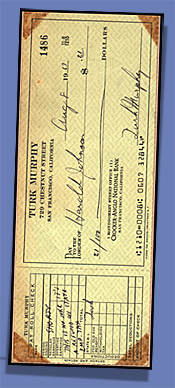 $21 Check from Turk Murphy to Hal Johnson 1967 |
The banjo craze that took America by storm in the late 1950s and early 1960s began in San Francisco on St. Patrick's Day of 1958 when a young college student and would-be entrepreneur named Jack Dupen opened a banjo/sing-along parlor on Broadway Street called the Red Garter. Suddenly there were lines around the block to get in and the establishment and it's trademark banjo bands were in demand. With plenty of draft beer flowing, peanut shells on the floor, and surly waiters, the sound of banjos, tubas and PEOPLE rang the rafters as well as the cash registers. Soon there were Red Garters, as well as copycat businesses, opening around the country and franchises were being snapped up right and left. Jack Dupen needed banjo players, tuba players, washboard players and piano players - soon there was an ample supply of each pouring into San Francisco. |
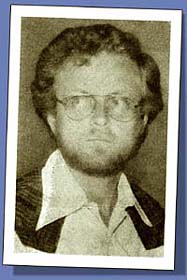 Jack Dupen Founder and Owner of the Red Garter chain of banjo parlors |
|||
|
|
|||||
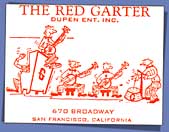 |
One such eager young banjo player was a kid fresh out of the University of Montana named Bill Rutan. Bill began as a TENOR banjo player but soon after arriving in San Francisco he learned that Dupen preferred his lead banjo players to play the longer neck PLECTRUM banjo. Rather than learn a new tuning, Bill borrowed a plectrum banjo and tuned it like a tenor, lowering the pitch of the strings so it would sound in the plectrum range. Before long Bill was a lead banjo player. Jack Dupen began opening Red Garters far afield and sending his best trained San Francisco lead players, as Bill had become, to plant the seed of a Red Garter in another city... New York, Chicago, Florence, Italy, New Jersey, Los Angeles, and New Orleans. Jack even opened a Red Garter franchise at the New York World's Fair in 1964. |
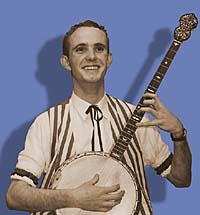 Bill Rutan - age 20 |
|||
|
|
|||||
| The Red Garter craze was also attracting some younger musicians to San Francisco. Stew Magee played trumpet in high school and moved to San Francisco to look for work. He found it at the Red Garter; but not as a musician at first, he started as a gofer and worked his way up to be a franchise owner and eventually opened the Los Angeles Red Garter. Another young banjo player was in high school as the Red Garter craze began: Dave Marty practiced hard to become an extra smooth banjo player as he apprenticed there. | |||||
|
|
|||||
 Milton Dargan "Peanuts" Fitch |
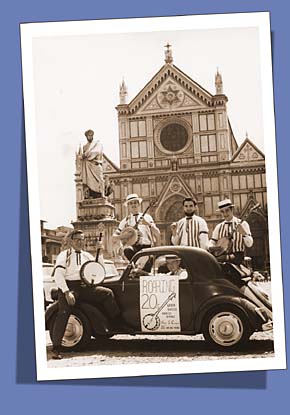 Bill Rutan - Red Garter Banjo Band Florence, Italy - l964 |
When Dupen opened the Red Garter in Italy in 1964 he sent Bill Rutan to spearhead the band. Bill came back to the U.S. to play at both the New York World's Fair in 1964 and the New Orleans Red Garter in 1965. In New York, Bill worked with a young banjo player that was small in stature but big in voice. He hailed from Atlanta, Georgia; his name was Milton Dargan "Peanuts" Fitch. Another Atlanta transplant on the World's Fair Red Garter band was a piano player named Pat Ryan.
|
|||
|
|
|||||
|
Across the city, in Greenwich Village a New Yorker named Joel Shiavone had opened a Red Garter franchise. He and Dupen had disagreed on a number of things and they soon split with Schiavone renaming his organization Your Father's Mustache. Schiavone began franchising his Mustache brand of banjo/sing-along clubs throughout the east. Schiavone added a trombone player to the mix to give the crowd a better sense of melody. He hired a banjo wizard from New Mexico who had been a minor league baseball player there, Ron Beisel, as his top lead man in his top club in the city. About this time a wandering trombone player from Oklahoma showed up in NYC, "Big Dave" Hanson, and Shiavone put him right to work. |
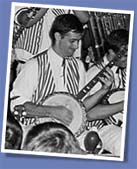 Joel Schiavone Founder and Owner of the Your Father's Mustache chain of banjo parlors |
||||
|
|
|||||
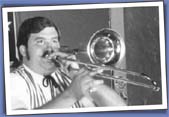 "Big Dave" Hanson
|
"Big Dave" really was "big"... about 265 pounds at about 6'5", he towered over everyone. The normal sized trombone looked like a toy in his hands. Dave was the son of a career Army officer and had moved about the US and Europe during his formative musical youth, eventually touring with Stan Kenton and other big bands. He had spent some time in San Francisco and New Orleans, learning Dixieland, and came to New York looking for a playing career. Dave had the ability to play the melody, which was somewhat rare in a trombone player, and that ability served him well as Schiavone felt the trumpet was too shrill for the crowded clubs. He claimed that people would sing better with a trombone playing the melody. Soon "Big Dave" was a fixture with the Mustache organization as he began to travel to the different clubs as a trombone sub, giving the various trombone players vacation time. Playing with so many different bands really improved Dave's ability to play the melody to hundreds of songs in any key. When Shiavone sent a Mustache band to warm up the live audience before each Sunday evening's Ed Sullivan network broadcast Dave was on board.
A young drummer from Atlanta who had gone to New York City looking for work was Jerry Garcia (not THE Jerry Garcia). He soon found employment as a percussionist at Your Father's Mustache. Joel Shiavone began adding washboard players to his banjo bands and Jerry designed his own washboard from pots and pans and thimbles and horns. |
||||
|
|
|||||
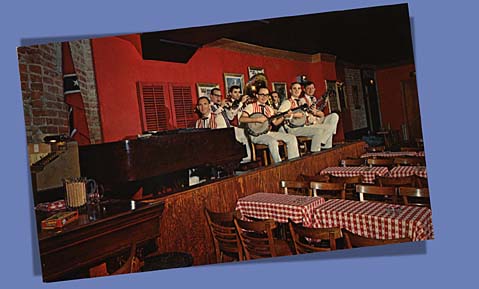
A Postcard from the New Orleans Red Garter - 1965 |
In 1965, with the World's Fair completed, the attention of the banjo/sing-along musicians turned towards New Orleans. Dupen opened a Red Garter in the French Quarter and Schivone opened a Father's Mustache just down the way. Hal Johnson and Ernie Carson left the familiar stomping grounds of San Francisco and the Turk Murphy band for the Crescent City. They were joined by "Peanuts" Fitch, Pat Ryan, Bill Rutan and a young bartender/trumpet player, Paul Thomas, from the World's Fair in New York. Stew Magee also came from the Red Garter organization in San Francisco. "Big Dave" Hanson and Phildelphia banjoist Ed Cuneo peopled the Mustache band. As they labored in the French Quarter, Pat Ryan began to think that a banjo/sing-along establishment might go over big in his hometown of Atlanta, so he began to make inquiries there for some investors and managers to help him launch that kind of operation. He asked Ed Cuneo to come on board and Hal began to talk to other musicians about moving to Atlanta. "Peanuts" was from Atlanta originally, so he was eager to go back. Ed Cuneo was chosen to lead the band on plectrum banjo. Jordan "Zim" Zimmerman signed on to play piano and the roster was complete. | ||||
|
|
|||||
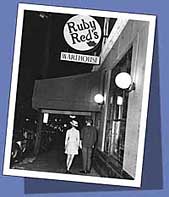 The Entrance to Ruby Reds 58 Ellis street - 1966 |
Pat Ryan's Atlanta partners, Al Sewell and Jerry Dilts, had secured a location in downtown Atlanta, at 58 Ellis Street, close to the downtown hotels and across the street from the Union Mission. The club, named Ruby Red's Warehouse, opened in late January of 1966. Hal Johnson had promised to stay at the New Orleans Red Garter through Mardi Gras (mid-February) and joined the band about 3 weeks after the opening.
The Ruby Red's Warehouse saw immediate success and soon had long lines at the door on weekends. The formula was lots of cold, draft beer and baskets of roasted peanuts. The customers threw their peanut shells on the floor. A staff of burly (and very funny) waiters kept the beer and peanuts coming as the crowd sang along to favorites played by the Ruby Red's Band. |
||||
|
|
|||||
| The original band lineup was:
Lead Banjo - Ed Cuneo |
|||||
|
|
|||||
 The original Ruby Reds Band at 58 Ellis Street, early 1966 |
|||||
|
|
|||||
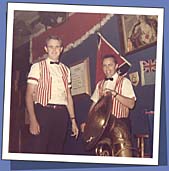 Bill Rutan and Hal Johnson Ruby Reds Warehouse 58 Ellis Street - 1967 |
Sometime in that first year Ernie Carson came in to replace "Zim" on piano. ("Zim" relocated to Savannah, Georgia to play in a similar club called Tom's Warehouse with left-handed banjo player Steve Schaefer and drummer Don Bartel). Ernie also doubled on cornet and could play piano and cornet at the same time. In November of 1966 Ed Cuneo and Pat Ryan had a disagreement and Ed moved on. Hal replaced Ed as the band leader and hired New York banjo player Terry Quinn to play lead banjo. The Ruby Red's Band recorded their first album with this lineup: Lead Banjo - Terry Quinn |
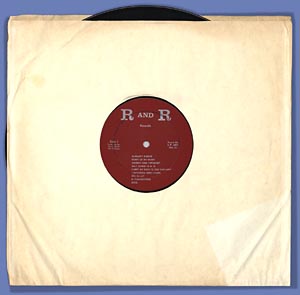 |
|||
|
The first LP by the Ruby Red's Band - 1966
The record was produced by Terry Quinn and Hal Johnson and was sold without a cover... just in the plain white sleeve as in the picture. [This recording is still available in vinyl and on CD. |
|||||
|
|
|||||
| The Ruby Reds Warehouse soon became even more successful as the rumors of real fun began to circulatate through town. Soon it was determined that only Atlanta-Fulton County Stadium was selling more draft beer in the state than Ruby Red's! In late 1967 San Francisco banjo player Dave Marty joined the band and replaced Terry Quinn on lead banjo. Quinn teamed with washboard/gutbucket bass player Ken Clark, who had been working at the Warehouse for a year or so, and they began creating an act for some of the Missisippi Show Boats. Eventually, they both migrated to San Francisco. (Later, Terry Quinn was killed while reportedly playing a game of Russian Roulette... Ken says it didn't happen that way.). |
 The Ruby Reds Band 1968 - 58 Ellis Street L-R; "Peanuts" Fitch, Hal Johnson, Bill Rutan and Ernie Carson |
||||
|
|
|||||
| Jazz guitarist Buddy Cooner took up the banjo and soon became a dependable sub when one was needed. Joe Grubbs, a native Atlanta tuba player subbed for Hal when needed. As the club got more popular Hal began to get more and more requests for gigs outside the club: picnics, house parties, corporate events... all manner of situations that called for a Dixieland banjo band. The Ruby Reds Band was slowly becoming less dependent on the Ruby Red's Warehouse for generating income for the musicians. The Ruby Red's Warehouse was expanding, as well. In 1969 the management of the club ventured out to create another Ruby Reds Warehouse in Crested Butte, Colorado. Paul Thomas, who was a bartender in the Wold's Fair Red Garter operation and part of the Red Garter management team in New Orleans, had moved to Atlanta in 1966 to help build Ruby Red's on Ellis Street. Paul was a master carpenter and also played a pretty mean trumpet. One feature of the Ruby Reds entertainment offering was that 4 or 5 times each night Paul, while bartending, would pull out his trumpet and play a wild chorus from behind the bar. Paul became the manager of Ruby Reds and was a logical choice to head up the operation in Crested Butte. A few years earlier, Stew Magee had left New Orleans to head up a franchise of the Red Garter in Los Angeles. Despite several years of hard work the L.A. club folded and Stew joined Paul Thomas in Colorado. The Crested Butte operation only lasted a few months and then Paul and Stew both moved to Atlanta where Paul took back the managerial reins at Ruby Red's and Stew, a multi-instrumentalist, began playing tuba, valve trombone and trumpet both in and out of the club. In 1968 long-time Red Garter banjoist Bill Rutan moved to Atlanta. The partners that owned and managed Ruby Red's Warehouse again branched out to form a club in Dallas and sent Dave Marty there to spearhead the band. Sometime in early 1969 that wandering trombonist, "Big Dave" Hanson came through Atlanta as part of a Your Father's Mustache band tour in support of comedian Flip Wilson. After the show, "Big Dave" sought a place to "sit in" and found the Ruby Reds Warehouse. Although he had never met Bill Rutan, "Peanuts" Fitch, Ernie Carson or Hal Johnson, they soon discovered that their paths had almost crossed several time in their past. |
|||||
|
|
|||||
| Dave had moved to New York just after Bill and "Peanuts" had left and he had moved to New Orleans just after the whole band had moved to Atlanta. Dave liked the band and the band liked Dave... so Dave left the Flip Wilson tour there and then and hired on with the Ruby Red's Band.
There was a rumor around Atlanta in 1967 and 1968. It was about an idea called "Underground Atlanta." It began as forgotten lanes and alleys that had been covered over when the city moved its streets up a story to accomodate the railroads that ran through the heart of Atlanta. By moving the traffic above and over the tracks, the citizens reduced the rail crossing accidents and cleared up congested traffic waiting for the trains. And all of that turn-of-the-century architecture just languished - hidden from view down there - until some enterprising folks came along and leased those ground floors cheap and resold the leases to bars and restaurants. The Original Underground Atlanta opened with a bang in 1969 and the first club to get their beer license was already Atlanta's most popular entertainment spot, a banjo/sing-along parlor called the Ruby Reds Warehouse. |
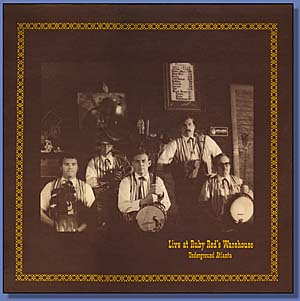
The second LP by the Ruby Reds Band - 1969 [This recording is still available in vinyl and on CD. |
||||
|
|
|||||
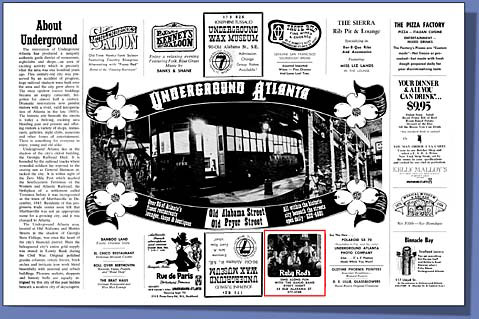 2-page Advertising Layout for Underground Atlanta from the August, 1973 edition of Where Magazine |
|||||
|
|
|||||
|
|
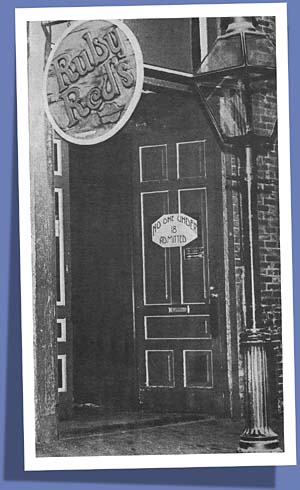 The Entrance to Ruby Reds Warehouse 53 Lower Alabama Streen Underground Atlanta - 1969 |
Almost overnight Underground Atlanta became a nationally known tourist spot, identified with the city of Atlanta throughout the country. The streets were full of tourists and locals alike along a 4 or 5 block area that was filled with every kind of entertainment establishment, restaurant and shop. Underground seemed like it might be successful forever but there was another peice of the puzzle just around the corner that would upset Underground's apple cart... MARTA. Eventually MARTA, the Metro Atlanta Rapid Transit Authority, would slice off about 1/3 of Underground's historic buildings and businesses as construction for the railway needed to follow the existing railroad right-of-way, which lay only a few yards from many of Underground Atlanta's establishments. That construction, combined with Georgia's lowered drinking age (down to 18 at the time), higher crime rates near the complex and a lack of unified management within the complex eventually turned Underground Atlanta into a ghost town. |
|||
|
|
|||||
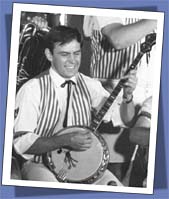 Ronnie Beisel |
The period from 1969 to 1976, starting with the move to Underground and ending when the building which housed the Ruby Reds Warehouse was demolished for MARTA, would have to be considered the heyday of the nightclub. During that time several personnel changes and business changes shaped the future form of the band. Hal and Bill were getting so many requests for outside gigs that they began to work less in the club and more around town. Hal went to New York to fetch the lead player at Your Father's Mustache: Ron Beisel. Ron accepted the invitation and moved to Atlanta where he became the lead banjo player for the remaining years of the Ruby Reds Warehouse. Ron persuaded Atlantan Jerry Garcia (again, not THE Jerry Garcia), also in New York, to bring his washboard apparatus home and soon Jerry was playing washboard, drums and providing many vocals with the Ruby Reds Band.
|
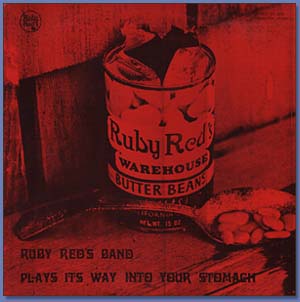
The third LP by the Ruby Reds Band - 1971
The record was produced by Dave Hanson [This recording is still available in vinyl and on CD. 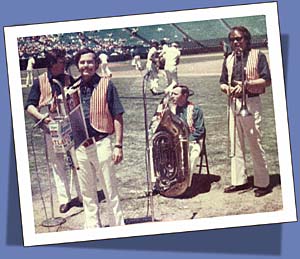 On The Field For The Braves L-R: Ron Beisel, Jerry Garcia, Hal Johnson, Skip Diringer |
|||
|
|
|||||
|
In 1973 the Atlanta Braves, under the ownership of Ted Turner, contracted with the Ruby Reds Band to play in Atlanta-Fulton County Stadium for each Braves home game. Hal set about creating crews of musicians for the gig, which was shared among most of the Ruby Red's musician personnel. The band continued to play home games in the 1973, 1974 and 1976 seasons until the night when Turner took over control of the team on the field. Baseball Commissioner Bowie Kuhn removed Turner within a day or two. "Ted was so mad he felt like he had to fire someone," Hal remembers, "so he fired the band!" |
|||||
|
|
|||||
 Summer Picnics became a staple of the band as they played at parks and picnic grounds throughout the metro Atlanta area. L-R: "Peanuts" Fitch, Hal Johnson, Herman Foretich and Bill Rutan. |
1976 was also the time when the Second Generation of musicians involved with Ruby Red's Band entered the picture in the form of a young piano player from Savannah, Georgia who moved to Atlanta in 1973 to attend art school. Rocky Ball began his college education at Georgia Southern College in Statesboro and played piano in various clubs on Savannah's famed River Street. Sometime in 1972 he wandered into a banjo/sing-along club in Savannah called Tom's Warehouse. On that particular night the piano player, Jordan "Zim" Zimmerman had passed out and the banjo player, Steve Schaefer, and the trombone player, Ron Feise, and the drummer, Don Bartel, were in a tight spot. Rocky came in with a group that encouraged him to get up and play some boogie-woogie barrelhouse piano on the band's break. He got a rousing round of applause, some free beer and an invitation to finish out the night on piano for "Zim." | ||||
|
|
|||||
| As "Zim" was often impaired, Rocky was often invited to sub at Tom's Warehouse and soon got to know the band pretty well. When he told them he was moving to Atlanta they provided him with a list of players to look up and seek gigging opportunities with. This list included all of the musicians in the Ruby Reds Band because "Zim" had left Ruby Reds Warehouse for Savannah and the Tom's Warehouse job.
When Rocky arrived in Atlanta to attend Georgia State University he would often go to Underground Atlanta for lunch, passing by the Ruby Reds Warehouse during the day when it was closed. He would often look in the window and occasionally go in and strike up a conversation with the cleaning crew but didn't have an opportunity to meet the musicians. Rocky also got a job immediately upon arrival in Atlanta playing barrelhouse piano at a Shakey's Pizza Parlor at night so he didn't have much opportunity to get out when the musicians were there. |
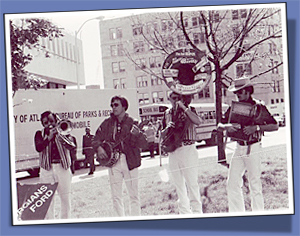 Ruby Reds Band at Woodruff Park for a City of Atlanta Parks & Recreation event - 1976 L-R: Stew Magee on valve trombone, Ron Beisel on banjo, Skip Dirringer on tuba, Rocky Ball on washboard |
||||
|
|
|||||
| Rocky soon further enhanced his music interests by forming a Dixieland band at Six Flags Over Georgia, called Raz'Mataz. Raz'Mataz was made up of excellent high school musicians, including a very young trumpet virtuoso named Lee King, and a great tuba player from Georgia State University named Mike Puckett. The group worked hard to learn much of the Dixieland repertoire. Soon thay had improved to the point that they were being asked to represent Six Flags all over town as they were often sent to major entertainment functions in the downtown hotels as 'good will' ambassadors for the amusement park. On many of these 'gigs' for Six Flags they came in contact with the more seasoned veteran professional musicians in Atlanta and became acquainted. It wasn't long before Rocky had met everyone on "Zim's" list! | |||||
|
|
|||||
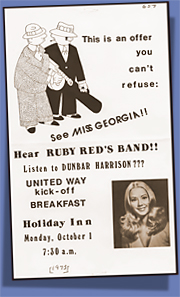 United Way Breakfast Athens, GA 1973 |
Whenever one of the pro bands was performing publicly, Rocky would organize a visit by Raz'Mataz to learn more about the music and the genre. In 1976 Raz'Mataz auditioned for and won a contract to play at a new Dixieland club in Atlanta, Dixie Daisy's. The club needed a band 6 nights a week but the other members of Raz'Mataz, by now in college, were unavailable during the week, so Rocky hired other musicians to keep all of the chairs full on the bandstand. He hired "Big Dave" Hanson on trombone, Hal Johnson on tuba, Bill Rutan on banjo, Herman Foretich on clarinet and Cricket Fleming on cornet. "Peanuts" Fitch was in the floor show for Dixie Daisy's and he and Rocky became friends.
Rocky also struck up a friendship with Bill Rutan and Bill soon encouraged him to take up the banjo because the piano was not portable. The Dixie Daisy's gig lasted only a few weeks and the club filed for bankruptcy. Across town at about the same time MARTA had displaced the Ruby Reds Warehouse and forced it to move across the street as the original building was demolished. By then Ron Beisel had Jerry Garcia on washboard and drums, Stew Magee on valve trombone and trumpet and Mike Puckett on tuba. With Dixie Daisy's filing bankruptcy, Rocky visited Ron Beisel at Ruby Reds to inquire about a piano job. Ron explained that the piano on the bandstand was just a prop... but they really needed a drummer as Garcia was leaving in a week. Rocky played a music set on drums and was hired. The next week, on Friday night as he arrived, he found the front door pad-locked. The Ruby Red's Warehouse had finally been forced to close. |
||||
|
|
|||||
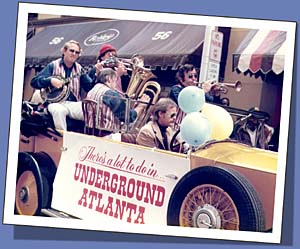 Dante's Parades One of many promotional parades in which The Ruby Reds Band and restauranteur Dante Stephenson teamed up to promote Underground Atlanta L-R: Bill Rutan, "Big Dave" Hanson, |
Rocky immediately began looking for work for himself, Ron and Stew and quickly found a steady for the band at a local Ramada Hotel lounge. Over the next year Ron Beisel, Stew Magee, Rocky Ball (on drums) and Ron's son, Mickey Beisel on bass, played a variety of steadies in local hotel lounges as the Ruby Red's Band. Sometime in 1976 Dante Stephenson, the President of the Undergound Atlanta Merchant's Association, hired Hal Johnson and the Ruby Reds Band to play on a street stage in Underground Atlanta. For 6 nights every week the band would play for passers-by. 3 different lead banjo players, Bill Rutan, Ron Beisel and Ed Cuneo, rotated nights on the little stage with Hal and a variety of tuba subs, including Joe Grubbs, Stew Magee, Skip Diringer and Mike Puckett. "Big Dave" Hanson shared the horn duties with Stew Magee (Stew played tuba, valve trombone and trumpet - a triple threat man!), Paul Thomas, Ernie Carson, Lee King and Skip Diringer (Skip played tuba and trombone). "Peanuts" played most every night and Rocky "sat in" most every night to learn Plectrum banjo. | ||||
|
|
|||||
| By 1977 the Ruby Reds Warehouse and Underground Atlanta began to fade further and further back as a memory in the minds of Atlantans. Atlanta began to grow exponentially OUTWARD and soon entertainment opportunitues, as well as businesses like restaurants, shopping malls, grocery stores, theaters, etc. began to surface in clusters near major suburban exits on I-285, the interstate ring around Atlanta. Before long everything you might want could be found in your neighborhood and the downtown experience for Atlantans became less and less important. The Ruby Reds Band, however, began to enter a new and profitable phase as it adapted readily to Atlanta's new key business: CONVENTIONS. | |||||
|
|
|||||
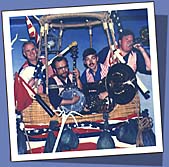 The Ruby Reds Band poses for a typical convention picture. L-R: Bill Rutan, |
Atlanta was fast becoming a convention town. First, Atlanta was a relatively NEW city in that the original city had been burned by Sherman during the Civil War. Much of Atlanta was very new and expanding at a rapid pace. The Atlanta airport, which is located very close to the downtown area, had room for expansion and was very modern. A rapid transit system was being built (its first leg took out about 1/3 of Underground!) which would link the airport to the downtown hotels. The state government of Georgia had begun building a trade show complex, the Georgia World Congress Center, that would rival those of Las Vegas and Chicago. Suddenly Atlanta was a desireable destination for conventions from all over the world. |
 The Ruby Reds Band Live at the Fox One of several appearances at the Fox Theater in Atlanta since 1966. L-R: Hal Johnson, Lee Floyd III, Ron Beisel and "Big Dave" Hanson |
|||
|
|
|||||
 The Ruby Reds Band in New York City L-R: Stew Magee, Hal Johnson Bill Rutan and "Big Dave" Hanson Eastern Airlines hired the Ruby Reds Band for a series of concerts in New York to promote the introduction of Eastern's new non-stop service to Atlanta. |
Those conventions employed meeting planners who would tailor their participant's experience to the destination city. Atlanta was the gateway to the Old South and the theme of banjos, southern belles, "Gone With The Wind", antebellum mansions, plantations and dixieland bands was a natural extension for themes in Atlanta. Quite soon dixieland bands and banjo players became the rage in this new market for musicians. The emphasis moved from club and steady work to the relatively easy and better money of 1-4 hour gigs in downtown hotel ballrooms and trade show halls. It seemed as if every guitar player in town began to take up the banjo and many bandleaders who had never played dixieland began booking that kind of work more steadily. | ||||
|
|
|||||
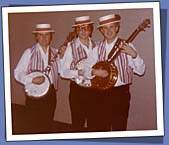 A Typical Convention Gig using 3 strolling banjos. L-R: Ron Beisel, Buddy Cooner and Bill Rutan |
The expertise of the personnel in the Ruby Reds Band became an advantage and the band soared to the forefront in the talent pool in Atlanta. It soon became commonplace for Hal Johnson to have 2 or 3 Ruby Reds Bands appearing across the city simultaneously. The depth of experience among the musicians ensured a great result regardless of the actual personnel on any particular gig. Since these fellows had been playing jobs with each other in a variety of combinations for years they were able to put forth a consistant Ruby Reds sound whenever and wherever they were called upon to do so. | ||||
|
|
|||||
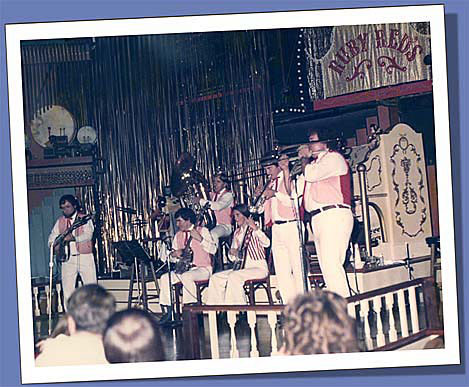 The Ruby Reds Warehouse in Marietta - 1980 L-R: "Peanuts" Fitch, Ed Cuneo, Hal Johnson, Van Paula Wilke, Lee King, "Big Dave" Hanson |
In 1980 Hal Johnson partnered with Atlanta restauranteur Bernie Isenstein to create a new Ruby Reds Warehouse in the suburbs of Atlanta, realizing that a downtown location was no longer viable. They chose the suburb of Marietta, an upscale community lying just outside I-285 on Atlanta's northwest side. Bernie found a large location that had been a family-oriented spaghetti emporium equipped with a giant pipe organ. The building was more lavishly decorated and appointed than the original Ellis Street or Underground locations. Hal put nearly everyone in the Ruby Reds band personnel list to work on a rotating basis. The main band featured Ed Cuneo on lead banjo, Van Paula Wilke on side banjo, "Peanuts" Fitch played banjo and handled the vocal duties, "Big Dave" Hanson on trombone, Lee King held forth on trumpet and Hal held down the tuba chair. The club had a run of 4-6 months and then faded. | ||||
|
|
|||||
| Hardly anyone noticed. By the 1980s the personnel that made up the Ruby Reds Band had hit upon a successful formula that prevailed through the 1990s and into 2001. The musicians made the transition from steadies and club work that was the norm in the 1950s, 1960s and into the mid 1970s to playing one-nighters at conventions, private parties and corporate events, each becoming independent contractors and bookers, leading their own bands under the Ruby Reds Band umbrella. By 1980 it was typical for any, if not all, of the musicians to create their own contacts and book their own gigs. In essence, each musician began to wear both hats of leader and sideman... creating a force of 15-20 salesmen selling Ruby Reds Band gigs and trading sideman services back and forth with the other musicians in the circle. |
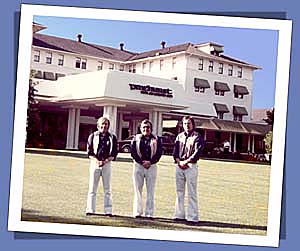 The Ruby Reds Band Hits The Road Throughout the go-go 1970s and 1980s the band played hundreds of road gigs. L-R: Hal Johnson, Stew Magee and Ron Beisel make one of many appearances at prestigious Pinehurst. |
||||
|
|
|||||
| Eventually the various musicians began to create their own branded bands: Ron Beisel and his son Mickey Beisel teamed with Atlanta banjoist Ben Johnson III and his son "Little" Ben Johnson IV to create a "Dixie/grass" father/son group called The Pioneers; Ernie Carson created his nationally known Capitol City Jazz Band; Stew Magee created the Peach Blossom Jazz Band; Hal Johnson and Bill Rutan became regular players in Don Erdman's globe-trotting Hotlanta Jazz Band; Rocky Ball, Lee King and Mike Puckett continued to play under the Raz'Mataz banner. The 1980's were a busy time for Atlanta dixieland players. | |||||
|
|
|||||
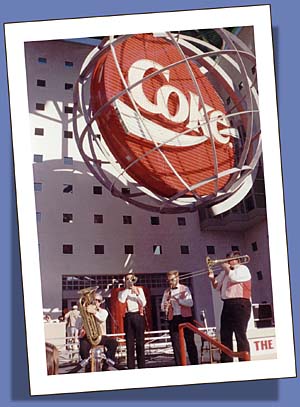 The Ruby Reds Band Entertains at The World of Coke Museum - Underground Atlanta L-R: Hal Johnson, Greg McLean, Don Erdman and "Big Dave" Hanson The Ruby Reds Band has represented corporations throughout the Southeast for over 48 years. |
Meanwhile, Underground Atlanta was erasing itself. MARTA had taken 1/3 of the complex in 1976. By 1978 only a few tenants were holding on. Crime and the rumors of crime began to escalate. Eventually the complex was forced to close and sat abandoned under the viaducts for several years. Many of the original buildings were lost to fires due to careless homeless people living in the empty buildings.
In the mid 1980s the City of Atlanta finally began to address the Underground problem. Atlanta's economy had shifted over the years to become heavily dependent on the Convention business and Atlanta had nothing to offer these visitors with regard to entertainment within walking distance of their downtown hotels. The idea that Undergound could be rebuilt was championed and soon the financing and plans were drawn up and ground was broken.
|
||||
|
|
|||||
|
Many supporters of the NEW Underground Atlanta wanted to include the clubs, restaurants and shops that had made the ORIGINAL Underground so well known and before long the cry went out to re-create, among others, the original Ruby Reds Warehouse. Some of the original owners of Ruby Reds got together, raised some money and began constructing a 1990's version. Hal Johnson was asked to consult on the music and he brought Rocky Ball along with the goal of finding a way to recreate at least the 'spirit' of the old sing-along club if not the exact repertoire. There was some concern, and justified, that the sing-along repertoire from the 60's had bypassed a couple of generations and would not be accepted, or even recognized, in 1990. Rocky's job was to create a NEW repertoire with the same crazy antics and fun that had made the original Ruby Reds so popular. |
|||||
|
|
|||||
| Along with playing in the Ruby Reds Band, Rocky had spent 14 years producing entertainment for several amusement parks around the country and had run into a lot of great talent along the way. He brought 2 of those talented people with him: A stride piano wizard named Arthur Turner from Pittsburgh, and a wild-man trumpet player from Atlanta named Marty Martin. "Big Dave" Hanson came on board as did "Peanuts" Fitch and a long-time Atlanta bass player, L.A. Tuten, learned the tuba and signed on as well. The crux of the new Ruby Reds Band was born with not only a repertoire of the original Dixieland but a solid grounding in Rock n'Roll, Bluegrass, Gospel and Western Swing. Of course, the veterans rotated through, as well, including Hal Johnson, Bill Rutan and Stew Magee. |
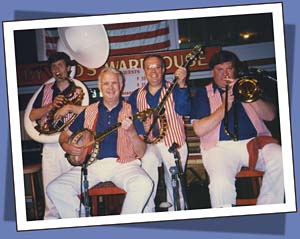 The NEW Ruby Reds Warehouse - 1991 On Pryor Street above Underground Atlanta L-R: L.A. Tuten, Bill Rutan, Dick Mott and "Big Dave" Hanson |
||||
|
|
|||||
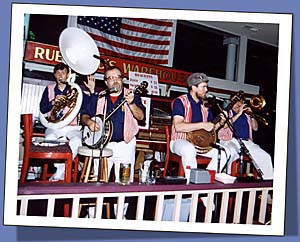 The NEW Ruby Reds Warehouse - 1991 On Pryor Street above Underground Atlanta L-R: L.A. Tuten, "Peanuts" Fitch, Rocky Ball, Stew Magee |
Unfortunately, the designers of the new Ruby Reds Warehouse lost sight of the essentials of the original club. Where once a smokey, dark, raucous, warehouse had been... now stood an elaborate up-scale restaurant surrounded by windows and sunshine... the environment was at war with the music. The new band persevered, however, and although they knew the outcome of this establishment was doomed they began to see a glimmer of what could be accomplished within the framework of their original goal. By early 1992, almost a year to the day after opening, the new Ruby Reds Warehouse folded. One day later a new establishment was born in the heart of the new Underground... Fanny Moon's Beer Hall. | ||||
|
|
|||||
| Rocky Ball, Marty Martin and Hal Johnson had leased a vacant spot and launched their own nightclub. At Fanny Moon's Beer Hall the 3 partners were finally allowed to accomplish what they could not do at the Ruby Reds Warehouse in the previous year. They were able to design, from the bottom up, a musical repertoire that entertained the general public and harkened back to the days of the original Ruby Reds clubs on Ellis Street and old Underground. The music had changed but the spirit of fun was still the same. They were soon joined by "Peanuts" Fitch who became a waiter and would surprise his customers by belting out several songs, crowd pleasers each and every one. Soon Flambeaux (we can't use his real name here), who was a waiter way back in 1966 on Ellis Street, joined the band on drums. He got his unusual name by shooting a giant flame from his mouth at the end of high-energy numbers! Fanny Moon's had a great 4 year run and the partners decided to close and pursue other interests in early 1996 as the Olympics came to Atlanta. The band continued to work as the Fanny Moon's Big Butt Band. Hal Johnson became more involved with Don Erdman's Hotlanta Jazz Band and tuba player L.A. Tuten found himself in the role of Hal's sub so often that their roles finally became reversed. September 11, 2001 created havoc in the music business all over the country. Atlanta was no exception. By the time the economy, and the music business, began to recover the musicians noticed a "paradigm shift". Many of the traits, habits and trends they had come to rely on in the go-go 1970s, 1980s and 1990s had changed and it was time for the Ruby Reds Band to adapt to that change. In 2002 Rocky Ball, Marty Martin and L.A. Tuten began to discuss amongst themselves the possibility of obtaining the rights to the Ruby Reds Band name and creating a new marketing campaign to promote the band and generate new revenue streams. As they began to test the recognition of the name amongst audiences in the Atlanta area they were encouraged to find a lot of enthusiasm for the Ruby Reds name and the traditions associated with it. As the team talked to more of the original players they found an equal enthusiasm amongst the musicians for continuing the name... and all of the musicians signed on to participate. In 2004 they obtained the rights from Hal Johnson with the pledge to add another 40 years to the band's legacy.
The Ruby Reds Band has been in business CONTINUOUSLY for 50+ years and celebrated it's 50th anniversary in early 2016. Stronger than ever, the band, through an infusion of seasoned second generaion players offers a vast musical panorama for its customers. The Ruby Reds Band has been wowin' them for 50 years with no end in sight! |
|||||
|
|
|||||
|
1968
|
2004
|
||||
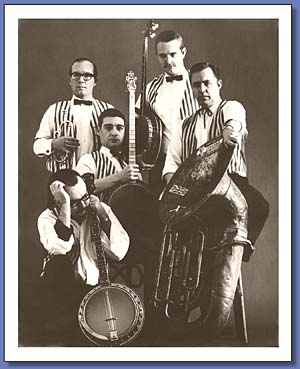 Everybody's Favorite Portrait of The Ruby Reds Band "'Peanuts' Grows Impatient" 1968 - 58 Ellis Street Top L-R: Ernie Carson, Abe Vandermulen, Bill Rutan, Hal Johnson and "Peanuts" Fitch as the Beaver (kneeling in dispair) |
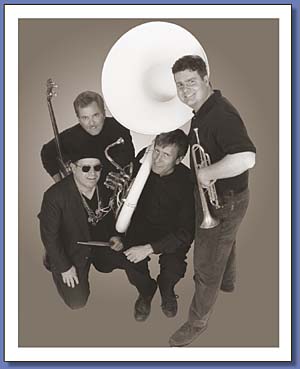 Ruby Reds Band 2004 Top L-R: Rocky Ball, L.A. Tuten Marty Martin and Flambeaux in sunglasses (we can't use his real name...) |
||||
|
|
|||
|
2010 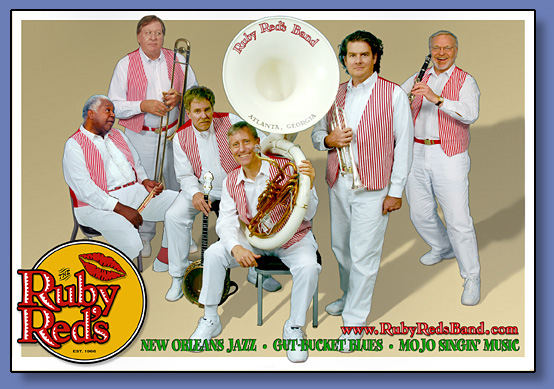 |
|||
|
Ruby Reds Band - 2010
L-R: Allen Murphy, Big Dave Hanson, Rocky Ball, |
|||
|
|
|||
|
2010
Ruby Reds Trio - 2010 L-R: Rocky Ball, L.A. Tuten, Marty Martin |
|||
|
|
|||
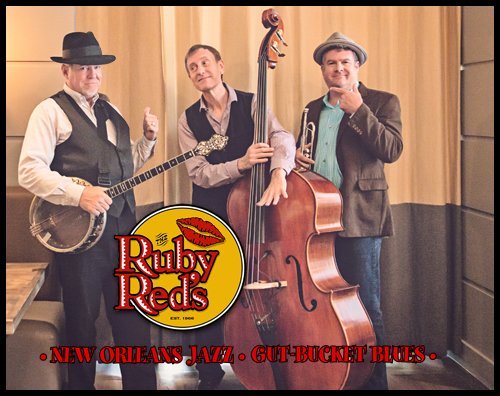 |
|||
|
Ruby Reds Trio - 2015 L-R: Rocky Ball, L.A. Tuten, Marty Martin |
|||
|
|
|||
|
|
|||
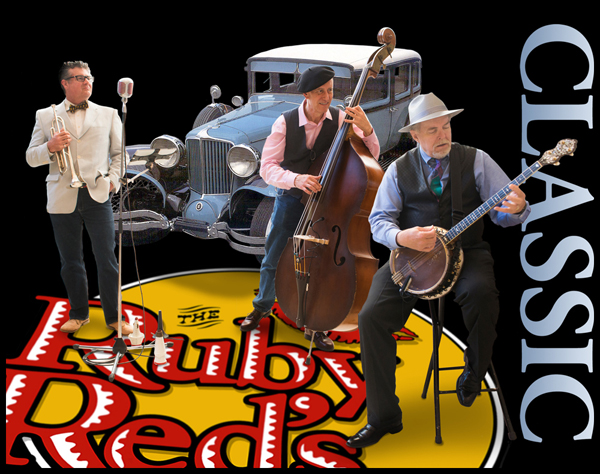 |
|||
|
L-R: Marty Martin, L.A. Tuten, Rocky Ball |
|
|
||
|
Copyright © 2005-2022 by The Ruby Reds Band • All Rights Reserved
web design by: ArtWorks Graphics |
||
|
|
||
|
About Us | History | Clients | Video | News | Prices & Availability | Recordings
Testimonials | Book the Band | Promotional Info | Agent Info | Contact Us | Top of Page | Home |
||
